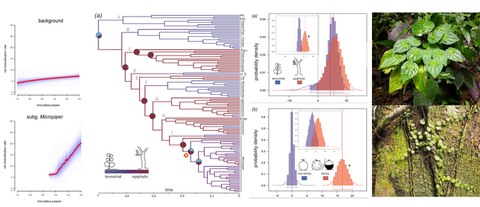Comparative Phylogenetics in Piperales
The Piperales is a species-rich plant order within the early diverging angiosperms. The taxonomy and evolution of its lineages has been a research interest at our institute since over a decade. As Piperales were little examined in the past, our first studies focused on resolving the phylogenetic relationships within the order and its families. Subsequent studies focused on growth form evolution and biogeographical research questions of this diverse plant group.
One of our most recent studies applies comparative phylogenetic analyses within the genus Peperomia, with ca. 1,600 species, one of the top ten of the most species rich genera. Comparative phylogenetics infer the history of taxa based on the evolutionary branching itself or under the influence of certain characters. Representatives of Peperomia show various life and growth forms and inhabit a broad range of vegetation types and geographical regions which makes them an interesting group to study. Phylogenetic analysis on Peperomia revealed a high variability of clade size on subgeneric level with species-rich clades and sister lineages comprising only few species. Analyses of diversification rates and trait evolution within Peperomia revealed a major diversification split event that is associated with transitions from the terrestrial to epiphytic life form becoming more frequently. Fruit stickiness arose two times independently during the evolution of the genus. It enhanced fruit dispersability and fostered species richness in the corresponding clades.
Based on a previous analysis of leaf crystal patterns our current studies focus on the evolution of CAM and its influence on diversification in Peperomia.
Contact:
Prof. Dr. Stefan Wanke E-Mail
Prof. Dr. Christoph Neinhuis E-Mail
Dr. Lena Frenzke E-Mail
Dr. Sarah Wagner E-Mail
Collaborators:
Dr. Marie-Stéphanie Samain (INECOL Pátzcuaro, Mexico)
Prof. Dr. Harry (Jack) Horner (Iowa State University, Ames, USA.)
Prof. Dr. James F. Smith (Boise State University, Idaho, USA)
Prof. Dr. Favio Gonzalez (Universidad Nacional de Colombia, Bogota, Colombia)
Dr. Karolina Heyduk (University of Georgia, Athens, USA)
Dr. Nick Rowe (AMAP, Montpellier, France)
Dr. Sandrine Isnard (IRD, New Caledonia)
Funding: Fazit-Stiftung, GA, DFG und DAAD
Selected Publications:
Horner H. T., Wanke S., Oelschlägel B. & Samain M. S. (2017). Peruvian window-Leaved Peperomia taxa display unique crystal macropatterns in high-altitude environments. IJPS, 178(2). 157-167.
Frenzke L., Samain M.-S., Symmank L., Goetghebeur P., Neinhuis C. & Wanke S. (2016). Evolution of epiphytism and fruit traits act unevenly on the diversification of the species-rich genus Peperomia (Piperaceae). Frontiers in Plant Science: 7:1145.
Isnard S., Prosperi J., Wanke S., Wagner S., Samain M.-S., Trueba S., Frenzke L., Neinhuis C. & Rowe Nick P. (2012). Growth form evolution in Piperales and its relevance for understanding angiosperm diversification: An integrative approach combining plant architecture, anatomy, and biomechanics. IJPS. 173. 610-639.

